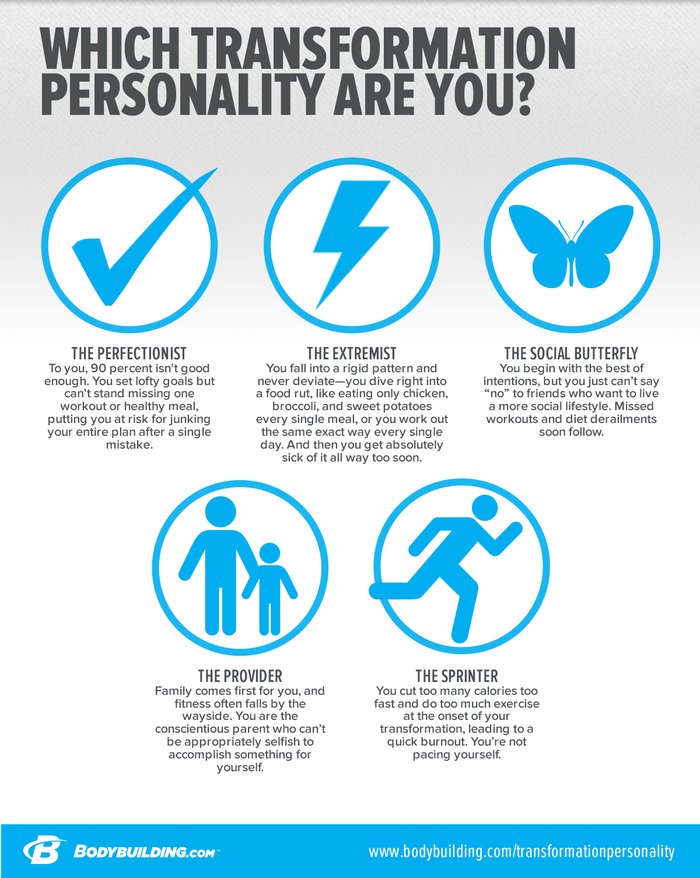A picture is worth a thousand words, and that's never more true than in the before-and-after photos from a successful three-month transformation challenge, like the longstanding "Body for Life" competition from EAS. The changes are oftentimes dramatic: Body fat is stripped away to reveal defined muscle mass, turning those grumpy "before" frowns upside down. And there's usually even a newfound golden tan that enhances the pics!
What those photos don't reveal? All the hard work, sacrifice, and dedication in the interim that made the "after" possible. The first 90 days is where many eager transformation candidates go awry. In fact, the vast majority of folks who begin such a journey never complete it.
While no two unsuccessful attempts are exactly alike, people tend to fall short for surprisingly similar reasons, identified here as five common personality types. If you recognize yourself in any of these personas, take heart; not only will you discover where you might go astray in your own transformation, you'll also get expert advice to help you steer clear of those mistakes so you can pair your "before" with an awe-inspiring "after."
1. The Perfectionist
To you, 90 percent isn't good enough. You set lofty goals but can't stand missing one workout or healthy meal, putting you at risk for junking your entire plan after a single mistake.
Quash your quirks: Perfectionists need to work on one key trait: the ability to accept less-than-perfect results, including tiny mistakes and small failures. In fact, coming up short is often a prerequisite for making any progress at all in life, as mistakes can offer the most potent lessons for growth and improvement.
Fitness model, lifestyle coach, and EAS Myoplex athlete Nikki Walter suggests perfectionists limit themselves to one intense pursuit at a time, and then break that goal down into smaller, attainable steps.
"Setting a lot of lofty goals seems like a great idea, but when you realize how much work and commitment it actually takes, it becomes easy to find excuses," she says. "Instead, pick one goal, and make a public commitment to it on BodySpace or other social media site." Announcing your goal—such as losing 15 pounds during a three-month transformation—gives you accountability, since friends and family will then see the goal and ask how things are going.
"Reporting small successes can keep perfectionists engaged and eager, because they most definitely don't want to show others they're incapable of not following through," says Walter. "Most likely competitive by nature, perfectionists want to prove naysayers wrong."

2. The Extremist
You fall into a rigid pattern and never deviate—you dive right into a food rut, like eating only chicken, broccoli, and sweet potatoes every single meal, or you work out the same exact way every single day. And then you get absolutely sick of it all way too soon.
Quash your quirks: The extremist, in many ways, is a lot like the perfectionist, in that failure in any one component of their fitness regimen can lead to a total crash and burn. The key here is to stretch out of one's comfort zone on a regular basis by incorporating small training and diet tweaks on a regular basis, and making such changes commonplace.
It's like climbing into a cold pool—eventually, after exposure to the chilly water, your body acclimates, and it doesn't feel like you're as cold anymore. The same goes for your overwhelming perceived need for rigidity in your approach.
As you intentionally shake up your workouts by introducing new exercises, rep schemes, and manipulating other variables—not to mention your diet by mixing and matching different food—you'll reach a point where you become acclimated to the idea that not everything needs to follow such a strict pattern to lead to results.
Walter has a useful tip for those who are set in their ways and tend to lose focus if just one detail is off-kilter: "For exercise ruts, I encourage clients to participate in group fitness classes or register for specialty classes," she says. "Mixing it up and committing to a group can sometimes make time go by faster. You don't have to think about what you're doing next, and it's also a good fix for someone who doesn't like to work out alone."

Mix up your training so you won't get easily bored.
3. The Social Butterfly
You begin with the best of intentions, but you just can't say "no" to friends who want to live a more social lifestyle. Missed workouts and diet derailments soon follow.
Quash your quirks: "For someone who likes to go out and is very socially active, I suggest thinking of their commitment for the first 90 days as a way to earn their way back into a social life," Walter says.
"Workouts should be a priority. If you have a Thursday happy hour, make a deal with yourself to do all you can to reach your fitness goals on all the other days of the week. Get up early, or use your lunch breaks if you want to keep a night open."
Active-duty Coast Guard member and EAS Myoplex athlete Steven Lopez says a social butterfly can't commit fully to fitness without running a real risk of failure, but he or she should prioritize fitness. "Develop a plan that will allow you to enjoy your social life on the weekends," he says. "You can do, say, a 'carb cycle' plan, in which you go low-carb Monday through Friday, and then on the weekends you can be flexible to enjoy your time with friends."
Although three months of limited social engagements may seem tough at the outset, seeing results from hard efforts can help propel the social butterfly forward. "After three months, if you've improved yourself, are healthier with a better metabolism, and have found ways to still be social, you'll be motivated to continue," Walter adds.
4. The Provider
Family comes first for you, and fitness often falls by the wayside. You are the conscientious parent who can't be appropriately selfish to accomplish something for yourself.
Quash your quirks: "As a family man myself with kids, I know trying to stay on course with your fitness goals can definitely get overwhelming at times," Lopez admits. "I certainly empathize with someone in this position."
The secret, Lopez says, is to devise strategies to help overcome the main obstacle, which is time management. "For example, if you're working out at night, you may be discovering that you're too tired after a long day's work, and then you come home and want to spend quality time with your family. If that's typical for you, I'd suggest coming up with a new early-morning routine that allows for a workout before going to your job—maybe even before the kids wake up.
"Getting the blood flowing early will also set the tone for the rest of the day," Lopez adds. "And then you also don't run the risk of an obstacle at work that might come up and dash a planned lunch or evening session. No matter what the time issue may be, the main point is to keep yourself motivated and find the best hour to train that works for your schedule so you can develop a routine."
If you’ve always dreamed of training in the morning but struggle to muster enough energy, a pre-workout supplement could be just what the trainer ordered. Pre-workout products like EAS Myoplex Pre-Workout typically contain caffeine (or other stimulants) to boost your energy, plus performance-support ingredients like beta-alanine and creatine to help you get the most out of your time with the iron. Taken 30 minutes before your workout—or even on your way to the gym for an early session—a pre-workout can help you beat the morning doldrums and get prepped for the task ahead.

Even with a solid strategy in place, the struggle for working parents to find time to train is real, Walter says. "I felt a lot of guilt after I became widowed and wanted to work out; my entire life, including my fitness goals, had to change. I had instantly become a single parent and didn't want to leave my five-year-old daughter alone or intrude on others to help watch her."
The solution? Walter installed a home gym next to her daughter's play area. "It was more motivating for me to have her nearby and watch her play dolls, or watch her movies," she recalls. "I also feel it's good for children to see their parents working out and living a healthy lifestyle. My daughter is now 10, and she'll work out with me occasionally. It's becoming a great way to spend time with her and have a little fun."

For Nikki Walter, being a single mom meant building a home gym, though it somewhat limited her exercise choices.
5. The Sprinter
You cut too many calories too fast and do too much exercise at the onset of your transformation, leading to a quick burnout. You're not pacing yourself.
Quash your quirks: "As a competitor, I've been there before—you're either behind the curve or just want to lean out quickly," Lopez admits. "Depending on how long you've been following a calorie-restricted diet, you might need to 'reset' and get your metabolism running strong again. Bumping up your daily calorie intake short term by adding in extra carbs or fat can help boost hormone levels and give you more energy during your workouts to allow you to continue progressing with your fat loss."
In the gym, you should consider a concept called microcycling. "If you're notorious for overdoing it in your training, commit to rotating between higher-intensity and lower-intensity workout days, while adjusting your diet accordingly," Walter suggests. "For example, on your higher-intensity days, you'll consume more calories, and on your less-intense cardio days, cut back on carbs."
To undo a chronic need to overtrain, if you don't work with a trainer, consider trying a fitness class instead of your own self-paced, self-regulated program. "Group fitness classes provide consistency," says Walter. "Classes are at scheduled times, and they can be a good way to pace yourself.
For example, if you plan on attending a boot camp, which is generally an overall body-circuit workout, then commit to a less-intensive lifting class on other days. The key here, of course, is to not overdo the classes, or you'll be in the same boat—no more than one a day, with at least 1-2 rest days per week."

If you're trying to lose fat, bumping up your calories short term can reset your metabolism, improve hormone levels, and give you more energy.

